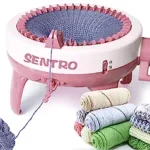Ah, the dreaded moment when you run out of yarn mid-knitting project! You're sitting there, happily clicking away with your needles, fully immersed in the soothing rhythm of the knit and purl. But as fate would have it, just when you reach the climax of your favorite Netflix show, you realize the yarn ball is rapidly shrinking.
Panic sets in, and you scramble to find a matching yarn from your stash. You locate one, but it's not an exact match, and now you're faced with a tough decision: do you embrace the color mismatch and call it a quirky design choice, or do you venture out to the yarn store in your pajamas, risking social humiliation?
After a brief internal debate, you decide to embrace the mismatch. But as you start knitting with the new yarn, you realize that your tension has gone haywire. The stitches are tighter than your jeans after a holiday feast! You desperately try to adjust, but it's like wrestling with an octopus on roller skates.
With determination, you forge ahead, hoping the tension discrepancy will magically even out. You continue knitting, fervently praying to the knitting gods for mercy. But alas, your scarf now resembles a rollercoaster of stitches, going up and down with no rhyme or reason.
In defeat, you decide to unravel the last few rows and find an alternative solution. You eventually drag yourself to the yarn store, where you're greeted by the enthusiastic staff, oblivious to your knitting crisis. After an eternity of indecisiveness, you settle on a suitable yarn match, feeling like a conqueror who has won a fierce battle.
Back home, you carefully change yarns, making sure to blend the transition as seamlessly as possible. You knit with newfound focus, hoping the scarf will forgive you for the yarn debacle. Finally, after what feels like a knitting marathon, your project is complete, and you hold up your finished scarf with a mix of pride and exhaustion.
As you admire your creation, you realize that knitting is an adventure full of unexpected twists and turns. It teaches you patience, resilience, and the art of embracing imperfections. And while you may have encountered a yarn change hiccup this time, you know that every knitting mishap only adds to the charm of your handmade creations.
Introduction
Knitting is a delightful craft that allows you to create beautiful and cozy items. However, running out of yarn during a project can be a common challenge. Fear not! In this comprehensive article, we will explore the art of changing yarn when knitting, guiding you through various techniques and tips to ensure a seamless transition in your knitting journey.
Planning Ahead
To avoid the dreaded "yarn shortage" situation, it's essential to plan your project carefully. Calculate the estimated amount of yarn needed based on your pattern and gauge. It's always wise to purchase an extra skein to have a buffer in case of unexpected changes in tension or gauge.
Choosing the Right Yarn
When transitioning to a new yarn, selecting the appropriate replacement is vital. Match the fiber content, weight, and color as closely as possible to maintain the consistency and appearance of your project. If an exact match isn't available, consider using a complementary color or embracing the contrast as a creative design choice.
Preparing for the Yarn Change
As you approach the end of your yarn ball, start planning for the transition. Complete the last stitch before you need to change yarn. Leaving a tail of the old yarn, introduce the new yarn by holding it together with the old yarn and knitting a few stitches. This will help secure the new yarn and avoid any gaps in your work.
The Russian Join Method
One popular technique for changing yarn is the Russian join. With this method, you can seamlessly attach the new yarn to the old one without weaving in any ends. To do this, overlap the ends of the old and new yarn, insert the needle through the overlapping section, and create a loop. Then, thread the new yarn through that loop and gently pull both yarn ends to snugly join them together.
The Weaving Method
Another common approach is the weaving method. Simply knit the first few stitches of the new row with both yarns held together. Then, drop the old yarn and continue knitting with the new yarn alone. After a few rows, you can weave in the loose ends of both yarns along the edge of your work for a neat finish.
The Felted Join Method
For wool or wool-blend yarns, the felted join method works wonders. Overlap the old and new yarn by a few inches, wet both ends, and rub them vigorously between your palms until they start to felt and fuse together. This creates a sturdy join that blends seamlessly into your knitting.
Using Stitch Markers
If you're working on a large project that requires frequent yarn changes, consider using stitch markers to identify the spots where you need to switch yarns. This can help you stay organized and ensure a smooth transition throughout your work.
Block Your Work
Once you've completed your project and woven in all the ends, block your work to even out the tension and stitches. Blocking can help disguise any minor irregularities and give your finished piece a polished appearance.
Conclusion
Changing yarn when knitting is an essential skill every knitter should master. By planning ahead, selecting the right yarn, and using appropriate techniques, you can achieve flawless transitions in your projects. Whether you opt for the Russian join, weaving method, or felted join, the key is to practice and find the method that works best for you. With these tips in hand, you can confidently tackle any knitting project, knowing that you have the know-how to seamlessly change yarn and create beautiful, professional-quality pieces to cherish for years to come. Happy knitting!
To find out more about knitting, please visit any of the following areas:
- How to sew together knitting
- What is brioche knitting
- How to join yarn in knitting
- How to join in the round knitting
- How to finish a knitting scarf
- How to make a slip knot for knitting
- How to switch colors knitting
- How to hold yarn when knitting
- What does kfb mean in knitting
- How to fix a dropped stitch in knitting
- How to hold knitting needles
- What is frogging in knitting?
- How to change colors in knitting
- How to count rows in knitting
- How to increase in knitting
- How to slip stitch knitting
- How to yarn over in knitting
- What is a knitting loom?
- How to make bobbles in knitting?
- Where can I buy sentro knitting machine?
- What can you make with a sentro knitting machine?
- Cricut Hat Press: A Comprehensive Guide on Usage - August 13, 2023
- Unlocking Creativity with the Cricut Joy: A Comprehensive Guide - August 12, 2023
- The Ultimate Guide to the Cricut Maker Bundle - August 11, 2023





